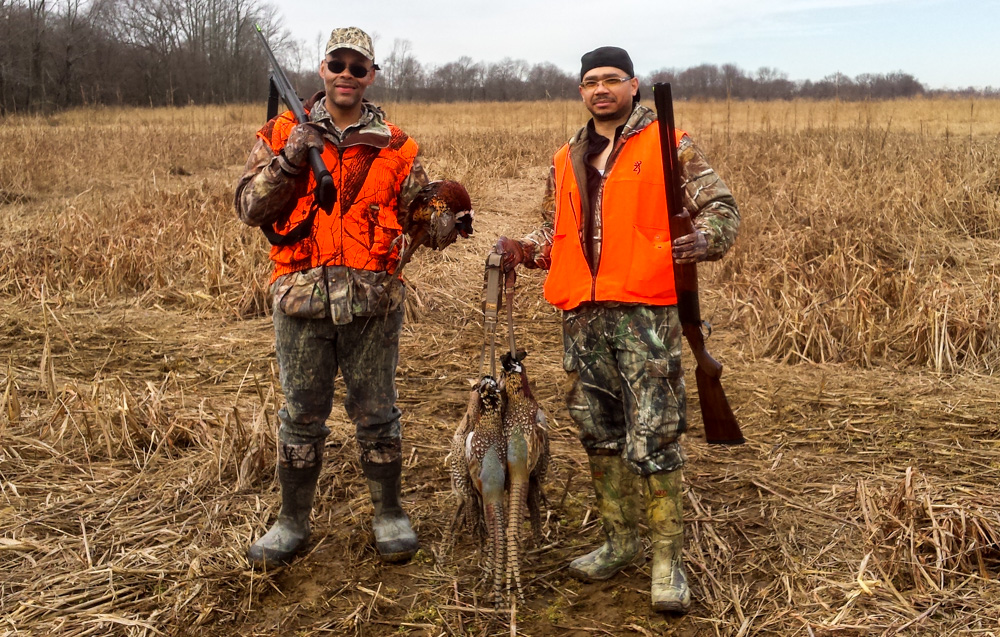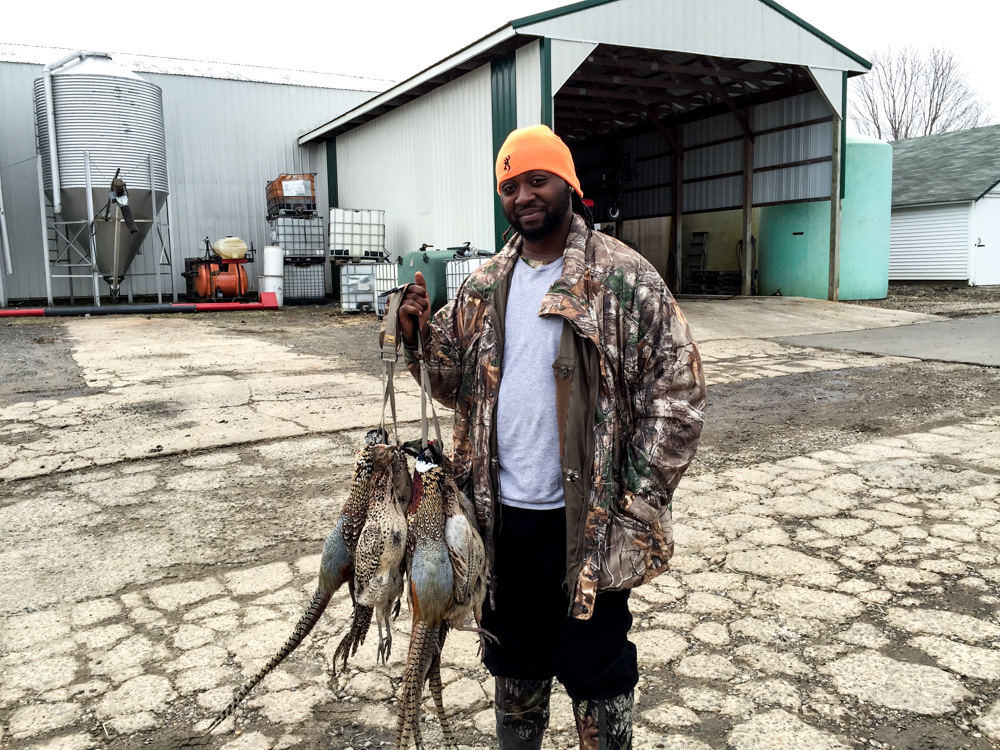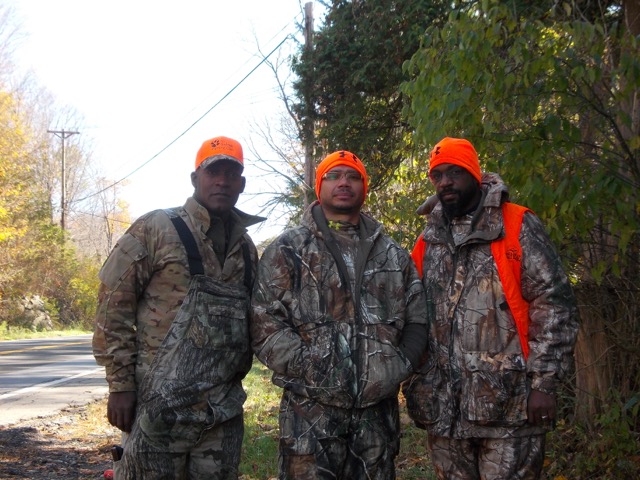Hunting For More Diversity…and a Few Deer
How a Crown Heights man is bringing the sport to black New Yorkers
Michael James, 40, always had an interest in hunting, but he never went on a hunt until he saw the aftermath of Hurricane Katrina on the news. The sight of helpless people crammed in the Superdome, or stranded on rooftops surrounded by floodwaters, waiting to be picked up by helicopters, unsettled him.
“Seeing people who were unable to do anything for themselves sparked something for me,” said the lifelong Crown Heights resident. “We’ve become a people who are basically consumers; anything happens to our food supply and we’re in trouble.”
That was all the motivation James, who works in customer service at New York Life, needed to wake up at 1 a.m. one Saturday in mid-November 2011, and drive three hours north to Columbia County with a bolt-action rifle and his friend Dwayne Nicholson, an experienced hunter. After a few pit stops to load up on hazelnut coffee, the two arrived at the woods by a family corn farm while it was still dark out. Walking through the twenty-degree cold in blaze orange vests and glowing headlamps, they arrived at the trees where they would shimmy up into high-chair-like tree stands, perched 15 feet above the ground, to shoot down on any deer that passed their way. But they didn’t have time to climb.
“Dwayne said he’s never seen it happen so fast,” said James during an interview this April. As the sun rose bright and orange over the forest, a doe emerged out of the woods, about 150 yards away, he recalled. James fired from the ground, but he didn’t hit the doe.
“I missed that one because of nerves,” he said. “But whether it’s your first or fiftieth time, your adrenaline starts to pump and it’s hard to keep the firearm steady.”
James had another chance to shoot a few minutes later, when a second doe emerged from the woods with her two fawns. James had climbed into his tree stand, but he was still pulling his gun up off the ground with a rope. Nicholson handed over his own rifle and James fired, a good hit to the heart and lung area. The doe ran another five yards before dying. The whole thing happened within 10 minutes.
“I was relieved that I managed to hit the doe,” said James. “The real moment was walking up to a dead animal and thinking ‘Holy shit! I have to field dress this thing.’”
The hard part of hunting is field dressing the animal: slicing it open up the middle and spilling its stomach, heart, lungs, and intestines onto the ground where it died, so that just the meat can be hauled away. The foxes, hawks, and crows clean up the rest. Once that was done, Nicholson and James hauled the meat and skin to a butcher in the nearby town of Hudson. At the end of the day they had 40 pounds of tasty, lean, low-sodium, and GMO-free meat. The doe’s fawns, meanwhile, could fend for themselves. After all, deer hunting season doesn’t start in New York state until mid-November, long after the fawns—born in May or June—have reached the end of their eight to ten week weaning period. For James, the doe’s meat wasn’t the only thing he found in the woods. He also discovered the simple joy of solitude.
“Because it’s so quiet, you can literally hear one leaf hit the ground, or the wind from the birds flying overhead,” said James. “Peace of mind is what I look forward to; getting away from the city, away from the hustle.”

James was hooked on the sport. So in January 2015, James, Nicholson, and two of their Crown Heights friends formed a hunting club, a rare sight in a city where a bodega sits on every block and where the nearest hunting ground is at least a 90-minute drive away. But there’s another thing which makes this urban hunting club unique: all of the members are black. James’ club is the New York City chapter of the Black Wolf Hunting Club, a Texas-based group that was started by an ex-army soldier named Eric Morris in 2011. The larger club has 20 members in Georgia, New York, Texas and Maryland, and the club’s ultimate goal is to get more African Americans involved in hunting and in the outdoors. Morris helps organize Black Wolf hunting trips across the country, and each month the club’s scattered members hold teleconferences about hunting laws and advice.
“After a few years of hunting, I googled ‘African American hunting clubs’ and I think like two popped up,” said James. “Not many blacks hunt.”
James’ five-person New York City chapter goes hunting two or three times a year, and the members—most of whom are neighbors in Crown Heights who have known each other for years—are always in contact through texting or Facebook. It’s just like any other hobby group but, according to a 2011 Fish & Wildlife Survey, only three percent of the nation’s 13.7 million American hunters are African American; 94 percent are white.
That wasn’t always the case. There used to be a lot more black hunters in the United States back when most black Americans lived in the rural south. Among the most famous of them was Holt Collier, a former slave from Mississippi who led a bear hunt with Theodore Roosevelt in 1902. But that all changed when the Great Migration happened from 1910 to 1970, when six million black Americans moved towards better economic prospects and what appeared to be less segregated cities in the Northeast, Midwest, and on the West Coast. The move brought many black Americans into large cities like New York and Chicago, where good hunting grounds are far away and the closest ones are often overcrowded.
“From the Great Migration on, you see it’s harder for people to carry on that hunting tradition if they don’t have access to it,” said Dr. Nicholas Johnson, a law professor at Fordham University and author of The Negro and The Gun: The Black Tradition of Arms. A lifelong hunter, he remembered hunting with black and white neighbors while growing up in rural West Virginia in the 1970s.
“Everyone that I knew hunted,” said Johnson. “People got their winter meat from deer hunting.” But West Virginia, he points out, is not very populated and the state has lots of public land, which makes it easy to find hunting grounds.
Johnson now lives in Bucks County, Pennsylvania, which borders Philadelphia and Trenton but also holds vast forested areas in the northwestern corner of the county. But there’s a problem: an overabundance of hunters. Johnson hasn’t hunted in over a decade because there are too many people hunting in the nearby woods.
“I tried to take my son out hunting where we are in Bucks County,” said Johnson, recounting a trip from 15 years ago. “But it was so crowded I thought it was dangerous. That was my only effort to get my kids involved in hunting because anything else would have been a long drive and lots of effort.”
For city-slickers like James, the founder of the NYC chapter, finding a place to hunt safely can be a lot of trouble.
“The drive to Columbia County is like three hours,” said James, who only goes hunting about five times a year. “And I have three small children, so I can’t just go off to hunt.”
Hunting isn’t the only sport lacking black participants. In a 2011 National Ski Areas Association survey, only 2 percent of the 67,000 skiers who responded to the survey identified as African-American. When it’s hard to access outdoor areas, fewer black Americans get involved in sports like skiing or hunting, says Ronto Roney, 26, a group therapist and mental health counseling student from New Jersey. That’s partly because there are fewer role models for them to follow into the sport.

“Getting into the hunting world is harder for African Americans because it’s a predominantly Caucasian sport,” said Roney, 26, who grew up raising snakes and pet salamanders. He said he always had a strong interest in the outdoors and in hunting, but couldn’t find anyone to introduce him to the sport until he found the Black Wolf Hunting Club last year. After he made contact with the New York City chapter, Roney went to a gun club in Egg Harbor Township to take an exam on New Jersey hunting protocol, so that he could get his hunting license.
“I was the only black hunter out of a room of 90 Caucasian guys,” said Roney. “People weren’t giving me funny looks, but it was uncomfortable for me because I was the only black person there. But people just talked with me about hunting.”
Despite the unbalanced numbers, none of the black hunters NY City Lens spoke to said they had encountered any racist hostility while hunting. But Eris Morris, 44, the founder of the Black Wolf Hunting Club, said that the lack of diversity can partly be explained by generations of interracial unease and suspicion. An experienced outdoor tour guide and fishing expert, Morris has noticed how difficult it is for white outdoor groups to access minority markets.
“Sometimes we self-segregate ourselves,” said Morris, who is black, “and there’s a lot of mistrust and fear as to why blacks don’t participate. I do everything in my power to try to turn that around.”
Morris is a self-taught hunter who grew up in suburban Atlanta. None of his family members knew how to hunt, though his dad and uncles sure knew how to skin a squirrel.
“When I was ten that was me hunting squirrels with a pellet gun around the neighborhood,” said Morris. “Now I do bow-hunting, black powder, knife, all of it. Knife is only done with hogs. You use the dogs to flush out the hogs and then you stab it right behind the shoulder, around the heart and lung area. It’s an adrenaline rush; up close and personal.”
Morris is passionate about bringing the up-close thrill of hunting to as many people as possible, regardless of race. While there are other black hunting clubs such as Buckwild Hunting Club in Sparta, Georgia, Morris thinks those clubs don’t do enough to attract newcomers. Even though the sport saw a nine percent increase in participation from 2006 to 2011, it’s still not very popular among any race. For example, out of the 247 million white Americans, only seven percent of them hunt.
“It’s not just a black thing,” said James, the founder of the NYC chapter. “The majority of white people don’t hunt either.” James believes that if more youngsters hunted, they would have a healthier relationship with guns, and perhaps the culture which promotes gun violence would fade away. (LINK HERE TO JAMES SCOUT STORY))
“I’ve seen kids playing Grand Theft Auto at five years old,” he said, about the violent video game. “If you’re taught that a gun is a tool to go hunting with then, it’s a tool. If it’s a weapon to kill someone, well…”
If James’ theory is true, black New Yorkers still face a big barrier to going hunting; it’s hard to legally own a gun around here. For example, it costs $340 just to apply for a gun license in New York City, and another $89.75 for the additional fingerprint fee. Plus, each applicant has to interview with the NYPD, and provide two references to speak to the applicant’s good character.((LET’S LINK THIS TO ADITI’S STORY WHEN IT GET’S READY)
“There are so many permits and tags it takes an extra effort to do this sport,” said James’ hunting buddy Dwayne Nicholson, whose North Carolina-born father was one of the few black New Yorkers to take his kids hunting in Dutchess County as they were growing up. Getting kids to hunt and learn how to use firearms safely as tools rather than dangerously as weapons would be a real kick for James and for Morris, the Black Wolf Hunting Club founder. The club is open to people of any race, but both James and Morris know they have a lot more work to do before more New York City kids start hunting.
“It’s like a store, once you open for business you have to be prepared to receive the customers,” said Morris, who is trying to get the club 501(c)(3) status so that they can raise more money to support hunting classes for kids. “There’s no shortage of people who want to learn, but it’s hard to find a person that has the knowledge to take interested people to the outdoors and train them to do it themselves.”
The club isn’t going to grow, Morris says, unless it has certified hunting instructors among its ranks, which is why James is studying to become one. So far the New York City chapter has only gone hunting together twice, and Roney is the only member from outside the Crown Heights clique.
“If we made T-shirts or went on the radio and all of a sudden we have 600 people, we would need more personnel,” said James. “We would need a treasurer, a CEO, a vice-president. So we try to do it by word of mouth for now.”
Still, James said he has received seven inquiries since the club started last January. The inquires came from people who found the group on Facebook, including Roney, who had his first real hunting experience in February, when the Brooklynites came down to New Jersey to hunt pheasants hiding in the tall grasses at Bent Creek Farms, about five miles west of Six Flags. Roney only got one pheasant because it was hard for him to hit the birds in mid-flight. But he enjoyed the sport so much that a month later he went on a hog hunt at night in the woods near San Antonio, Texas, where he said he really got his adrenaline pumping.
Roney said he and his friends had tracked down a 230-pound boar with the help of two dogs. “We had already stabbed it but it wouldn’t go down,” he said, “so I stuck it three or four times on the broad side where the lungs are.” Roney said that the boar was squealing, and that some of its blood shot out onto his face and shirt, which had a picture of Superman flying through the air on it. After watching so many hog hunting videos, Roney didn’t mind the mess.
“Being out there with the dogs, watching them look for the trail,” he said. “Then stabbing the boar and walking back at night; hearing the owls and the bugs, that was probably the most fun I’ve had hunting.”
No worries about the food supply here; these guys can fend for themselves.
The Impact
One Shoe At A Time: A Mother Turns Pain Into Purpose
An Unsolved Shooting Baffles a Mom for Two Decades
How Grief and Anger Turned Into Action
Silver Gun: A Robbery in Queens
Shooter: “It’s Either Them or Me”
After a Single Dad is Shot, a Community Reels
